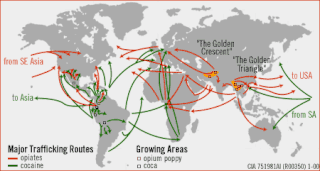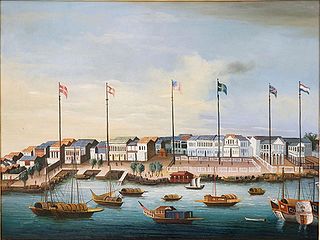 W
WThe illegal drug trade or drug trafficking is a global black market dedicated to the cultivation, manufacture, distribution and sale of prohibited drugs. Most jurisdictions prohibit trade, except under license, of many types of drugs through the use of drug prohibition laws. The think tank Global Financial Integrity's Transnational Crime and the Developing World report estimates the size of the global illicit drug market between US$426 and US$652 billion in 2014 alone. With a world GDP of US$78 trillion in the same year, the illegal drug trade may be estimated as nearly 1% of total global trade. Consumption of illegal drugs is widespread globally and it remains very difficult for local authorities to thwart its popularity.
 W
W1-(2-Chloro-N-methylbenzimidoyl)cyclopentanol, sometimes misleadingly referred to as hydroxylimine hydrochloride, is a chemical compound which is the final intermediate in the synthesis of ketamine, an anaesthetic drug which is also subject to recreational abuse. This chemical intermediate is not active as a drug in its own right, and is legal in most countries, but is readily converted into ketamine by dissolving it in a suitable high-boiling point solvent and heating, with no other chemicals required. This has made it subject to illicit trade as a drug precursor, and it has sometimes been seized by law enforcement agencies in significant quantities, leading to it being specifically banned as a controlled drug precursor in some jurisdictions such as Taiwan.
 W
WIn certain countries illegal importing, exporting, sale, or possession of drugs constitute capital offences and may result in a death sentence. A March 2018 report by Harm Reduction International says: "There are at least 33 countries and territories that prescribe the death penalty for drug offences in law. ... Between January 2015 and December 2017, at least 1,320 people are known to have been executed for drug-related offences - 718 in 2015; 325 in 2016; and 280 in 2017. These estimates do not include China, as reliable figures continue to be unavailable for the country."
 W
WThe United States Central Intelligence Agency (CIA) has been accused of involvement in drug trafficking. Books and investigations on the subject that have received general notice include works by the historian Alfred McCoy, professor and diplomat Peter Dale Scott, journalists Gary Webb and Alexander Cockburn, and writer Larry Collins. These claims have led to investigations by the United States government, including hearings and reports by the United States House of Representatives, Senate, Department of Justice, and the CIA's Office of the Inspector General.
 W
WA number of writers have alleged that the United States Central Intelligence Agency (CIA) was involved in the Nicaraguan Contras' cocaine trafficking operations during the 1980s Nicaraguan civil war. These claims have led to investigations by the United States government, including hearings and reports by the United States House of Representatives, Senate, Department of Justice, and the CIA's Office of the Inspector General which ultimately concluded the allegations were unsupported. The subject remains controversial.
 W
WA drug house is a residence used in the illegal drug trade. Drug houses shelter drug users and provide a place for drug dealers to supply them. Drug houses can also be used as laboratories to synthesize (cook) drugs, or cache ingredients and product.
 W
WDrug barons of Colombia refer to some of the most notable drug lords which operate in illegal drug trafficking in Colombia. Several of them, notably Pablo Escobar, were long considered among the world's most dangerous and most wanted men by U.S. intelligence. "Ruthless and immensely powerful", several political leaders, such as President Virgilio Barco Vargas, became convinced that the drug lords were becoming so powerful that they could oust the formal government and run the country.
 W
WThe Drug Court of New South Wales is an inferior court constituted as a court of record within the Australian court hierarchy with its jurisdiction limited to New South Wales, Australia. It is a specialist court that deals with criminal offences in which the defendant has an addiction to illicit drugs. The Court exercises both local and district court jurisdiction and has a similar status to the District Court of New South Wales.
 W
WFenethylline is a codrug of amphetamine and theophylline that behaves as a prodrug to both of the aforementioned drugs. It is also spelled phenethylline and fenetylline (INN); other names for it are amphetaminoethyltheophylline and amfetyline. The drug was marketed for use as a psychostimulant under the brand names Captagon, Biocapton, and Fitton.
 W
WFushin-sen is a Japanese term that generally refers to all seaborne vessels that behave suspiciously.
 W
WOrganised crime in Colombia refers to the activities of various groups of drug cartels, guerilla groups, organised crime syndicates or underworld activities including drug trafficking, contract killing, racketeering and other crimes in Colombia. Colombia has seen the rise and fall of drug empires, crime syndicates and organised guerrilla groups, all of which having contributed to the varying forms of organised crimes having occurred in Colombia.
 W
WThe alleged illicit activities of the North Korean state include manufacture and sale of illegal drugs, the manufacture and sale of counterfeit consumer goods, human trafficking, arms trafficking, wildlife trafficking, counterfeiting currency, terrorism, and other areas. It is alleged many of these activities are undertaken at the direction and under the control of the North Korean government and the ruling Workers' Party of Korea, with their proceeds going towards advancing the country's nuclear and conventional arms production, funding the lifestyles of the country's elite, and propping up the North Korean economy.
 W
WN-isopropylbenzylamine is a compound that has appeared in chemical literature often playing an intermediary role in applications of experimental synthesis and novel organic transformations. Despite having limited documented uses, it is most well known for having previously come to the attention of the DEA due to being used by illicit methamphetamine manufacturers as a diluent of or substitute for methamphetamine, with many recorded sightings occurring in the years 2007-2008. As of 2018, researchers from the DEA associated with the Methamphetamine Profiling Program, which categorizes route-specific and other impurities in seized drug samples, has stated that isopropylbenzylamine appears only "occasionally". This compound is a chain isomer of methamphetamine that exhibits the same chemical formula and molar mass giving their hydrochloride salts similar physical properties, such as relatively close melting points and comparable appearance. Consequently, it can be used as a substitute or diluent of methamphetamine without this being obvious to users, though the differing melting points and various attributes of its presentation such as softer or more easily broken crystals have been noted as a possible indication of its presence. In Australia it is known to be a border controlled substance. It currently is unknown to be a controlled substance in any other jurisdiction. Isopropylbenzylamine is not thought to have any stimulant effects in its own right, though anecdotal reports suggest that it may be associated with side effects such as headaches and confusion which are not typically associated with methamphetamine itself. The toxicity of N-isopropylbenzylamine has not been studied. Other "cutting agents" found to have been used for methamphetamine include the related compounds methylbenzylamine and ethylbenzylamine, as well as dimethylsulfone.
 W
WLa Castellane is a neighbourhood in the 15th arrondissement of Marseille, France. Built as a Modernist council estate in the 1960s for French refugees of the Algerian War of 1954–1962, it is now home to about 7,000 residents, many of whom are second-generation French citizens. The neighbourhood is plagued by unemployment, drug trafficking, prostitution and arms smuggling.
 W
WThe illegal drug trade in Latin America concerns primarily the production and sale of cocaine and cannabis, including the export of these banned substances to the United States and Europe. The Coca cultivation is concentrated in the Andes of South America, particularly in Colombia, Peru and Bolivia; this is the world's only source region for coca.
 W
WMoonshine is high-proof liquor that was and continues to be produced illicitly, without government authorization. The name was derived from a tradition of creating the alcohol during the nighttime, thereby avoiding detection. Distilling such spirits outside a registered distillery remains illegal in most countries.
 W
WNarco-state is a political and economic term applied to countries where all legitimate institutions become penetrated by the power and wealth of the illegal drug trade. The term was first used to describe Bolivia following the 1980 coup of Luis García Meza which was seen to be primarily financed with the help of narcotics traffickers. Other well-known examples are Mexico, Colombia, and Guinea-Bissau, where drug cartels produce, ship and sell drugs such as cocaine and marijuana.
 W
WThe Narcotics Control Bureau is an Indian central law enforcement and intelligence agency under the Ministry of Home Affairs, Government of India. The agency is tasked with combating drug trafficking and the use of illegal substances under the provisions of Narcotic Drugs and Psychotropic Substances Act.
 W
WThe New Bilibid Prison drug trafficking scandal is a criminal investigation and political scandal concerning allegations of government involvement in illegal drug trade at the New Bilibid Prison in Muntinlupa, Metro Manila, Philippines. The allegations were made by President Rodrigo Duterte after announcing that the two top convicted drug lords in the country continued to run their drug rings from inside the national penitentiary with former administration officials and their local government cohorts as co-conspirators. On August 25, 2016, Duterte released a drug matrix showing the structure of drug trafficking operations at the New Bilibid Prison and identified the two former top officials of the Department of Justice, the former provincial governor and board member of Pangasinan, and the former Bureau of Corrections director as being involved in the Bilibid narcotics trade.
 W
WThe Old China Trade refers to the early commerce between the Qing Empire and the United States under the Canton System, spanning from shortly after the end of the American Revolutionary War in 1783 to the Treaty of Wanghia in 1844. The Old China Trade represented the beginning of relations between the United States and East Asia, including eventually U.S.–China relations. The maritime fur trade was a major aspect of the Old China Trade, as was illegal trafficking in opium, with the trade era overlapping the First Opium War waged by China against Western traders and blockade-runners between 1839-1842.
 W
WA rolling meth lab is a transportable laboratory that is used to illegally produce methamphetamine. Rolling meth labs are often moved to a secluded location where the strong, toxic fumes of methamphetamine manufacture cannot be detected and where the toxic manufacturing byproducts can be discarded. They are sometimes designed to manufacture the drug while the lab is traveling.
 W
WRachel Jayne Whitear was a young woman from Withington, Herefordshire, who died of a heroin overdose in Exmouth, Devon, in May 2000 at the age of 21. She had been a frequent user of the narcotic for two years, having been introduced to heroin usage by her partner, Luke Fitzgerald, in 1998.